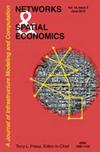The Impact of Railway Transport on the Socioeconomic Development of Territories
IF 1.5
3区 工程技术
Q3 OPERATIONS RESEARCH & MANAGEMENT SCIENCE
引用次数: 0
Abstract
Recent studies in the field of socioeconomic development of the country’s regions show high intensity and versatility, but they do not sufficiently assess the transformation of territories in conjunction with the functioning of railway transport, as an important element in ensuring sustainable growth. The content of the work is aimed at establishing the impact of rail transport on the socio-economic development of regions. The theoretical provisions of the spatial economy constitute the methodological basis of the study. The research methods are bibliometric analysis, in particular the analysis of the frequency of using keywords (co-occurrence analysis), methods of comparative, correlation and regression analysis. The empirical basis of the study includes publications indexed by the Scopus database, as well as official statistical information on the functioning of railway transport and the level of socioeconomic development of the territories, which Russian Railways operates, for the period 2010–2020. The initial data were processed using VOSviewer 1.6.18, EViews 13, Stata/MP 14.2. The article tests the assumption that there is a correlation between the results of railway transport and gross regional product as a characteristic of the socio-economic development of the regions of the Russian Federation. The approach involves checking the cross-dependence and stationarity of variables, performing a Pedroni and Kao panel cointegration analysis, estimating the parameters of the cointegrating regression, and conducting a Dumitrescu – Hurlin causality panel analysis. The research results empirically substantiate the existence of long-term, bidirectional and unidirectional causal relationships between the parameters of the functioning of the railway transport and GRP铁路运输对区域社会经济发展的影响
最近关于该国各区域社会经济发展领域的研究显示出高度的强度和多样性,但它们没有充分评价结合铁路运输功能的领土转变,而铁路运输是确保可持续增长的一个重要因素。工作内容旨在确定铁路运输对各地区社会经济发展的影响。空间经济的理论规定构成了研究的方法论基础。研究方法主要有文献计量分析,特别是关键词使用频率分析(共现分析)、比较分析、相关分析和回归分析等方法。该研究的实证基础包括Scopus数据库索引的出版物,以及俄罗斯铁路公司运营的2010-2020年期间铁路运输功能和地区社会经济发展水平的官方统计信息。初始数据采用VOSviewer 1.6.18、EViews 13、Stata/MP 14.2进行处理。这篇文章检验了一种假设,即铁路运输的结果与作为俄罗斯联邦各地区社会经济发展特征的区域生产总值之间存在相关性。该方法包括检验变量的相互依赖性和平稳性,进行Pedroni和Kao面板协整分析,估计协整回归的参数,并进行Dumitrescu - Hurlin因果面板分析。研究结果实证证明了铁路运输运行参数与GRP之间存在长期、双向和单向的因果关系
本文章由计算机程序翻译,如有差异,请以英文原文为准。
求助全文
约1分钟内获得全文
求助全文
来源期刊

Networks & Spatial Economics
社会科学-运筹学与管理科学
CiteScore
4.00
自引率
4.20%
发文量
26
审稿时长
>12 weeks
期刊介绍:
Networks and Spatial Economics (NETS) is devoted to the mathematical and numerical study of economic activities facilitated by human infrastructure, broadly defined to include technologies pertinent to information, telecommunications, the Internet, transportation, energy storage and transmission, and water resources. Because the spatial organization of infrastructure most generally takes the form of networks, the journal encourages submissions that employ a network perspective. However, non-network continuum models are also recognized as an important tradition that has provided great insight into spatial economic phenomena; consequently, the journal welcomes with equal enthusiasm submissions based on continuum models.
The journal welcomes the full spectrum of high quality work in networks and spatial economics including theoretical studies, case studies and algorithmic investigations, as well as manuscripts that combine these aspects. Although not devoted exclusively to theoretical studies, the journal is "theory-friendly". That is, well thought out theoretical analyses of important network and spatial economic problems will be considered without bias even if they do not include case studies or numerical examples.
 求助内容:
求助内容: 应助结果提醒方式:
应助结果提醒方式:


